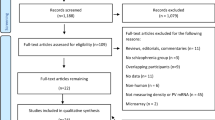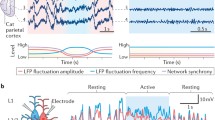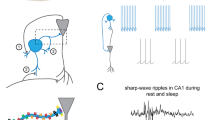Abstract
The hypothesis that alterations of cortical inhibitory γ-aminobutyric acid (GABA) neurons are a central element in the pathology of schizophrenia has emerged from a series of postmortem studies. How such abnormalities may contribute to the clinical features of schizophrenia has been substantially informed by a convergence with basic neuroscience studies revealing complex details of GABA neuron function in the healthy brain. Importantly, activity of the parvalbumin-containing class of GABA neurons has been linked to the production of cortical network oscillations. Furthermore, growing knowledge supports the concept that γ band oscillations (30–80 Hz) are an essential mechanism for cortical information transmission and processing. Herein we review recent studies further indicating that inhibition from parvalbumin-positive GABA neurons is necessary to produce γ oscillations in cortical circuits; provide an update on postmortem studies documenting that deficits in the expression of glutamic acid decarboxylase67, which accounts for most GABA synthesis in the cortex, are widely observed in schizophrenia; and describe studies using novel, noninvasive approaches directly assessing potential relations between alterations in GABA, oscillations, and cognitive function in schizophrenia.
Similar content being viewed by others
References
Papers of particular interest, published recently, have been highlighted as: • Of importance, •• Of major importance
Green MF: What are the functional consequences of neurocognitive deficits in schizophrenia? Am J Psychiatry 1996, 153:321–330.
Fries P: Neuronal gamma-band synchronization as a fundamental process in cortical computation. Annu Rev Neurosci 2009, 32:209–224.
•• Klausberger T, Somogyi P: Neuronal diversity and temporal dynamics: the unity of hippocampal circuit operations. Science 2008, 321:53–57. This is an outstanding review article highlighting the involvement of multiple subtypes of GABA neurons in the mechanisms of cortical network oscillations in vivo.
• Gonzalez-Burgos G, Lewis DA: GABA neurons and the mechanisms of network oscillations: implications for understanding cortical dysfunction in schizophrenia. Schizophr Bull 2008, 34:944–961. This is an updated review of current knowledge on the role of GABA neuron–mediated inhibition in the mechanisms of network oscillations and their alterations in schizophrenia.
Bartos M, Vida I, Jonas P: Synaptic mechanisms of synchronized gamma oscillations in inhibitory interneuron networks. Nat Rev Neurosci 2007, 8:45–56.
Mann EO, Paulsen O: Role of GABAergic inhibition in hippocampal network oscillations. Trends Neurosci 2007, 30:343–349.
Wulff P, Ponomarenko AA, Bartos M, et al.: Hippocampal theta rhythm and its coupling with gamma oscillations require fast inhibition onto parvalbumin-positive interneurons. Proc Natl Acad Sci U S A 2009, 106:3561–3566.
Lisman J, Buzsaki G: A neural coding scheme formed by the combined function of gamma and theta oscillations. Schizophr Bull 2008, 34:974–980.
Hajos N, Paulsen O: Network mechanisms of gamma oscillations in the CA3 region of the hippocampus. Neural Netw 2009, 22:1113–1119.
Fuchs EC, Zivkovic AR, Cunningham MO, et al.: Recruitment of parvalbumin-positive interneurons determines hippocampal function and associated behavior. Neuron 2007, 53:591–604.
• Lisman JE, Coyle JT, Green RW, et al.: Circuit-based framework for understanding neurotransmitter and risk gene interactions in schizophrenia. Trends Neurosci 2008, 31:234–242. This is an important article proposing integrative hypotheses of schizophrenia relating alterations in GABA-mediated inhibition and glutamate-mediated excitation.
Cull-Candy SG, Leszkiewicz DN: Role of distinct NMDA receptor subtypes at central synapses. Sci STKE 2004, 2004:re16.
Maccaferri G, Dingledine R: Control of feedforward dendritic inhibition by NMDA receptor-dependent spike timing in hippocampal interneurons. J Neurosci 2002, 22:5462–5472.
Hu H, Martina M, Jonas P: Dendritic mechanisms underlying rapid synaptic activation of fast-spiking hippocampal interneurons. Science 2010, 327:52–58.
Gonzalez-Burgos G, Kroener S, Seamans JK, et al.: Dopaminergic modulation of short-term synaptic plasticity in fast-spiking interneurons of primate dorsolateral prefrontal cortex. J Neurophysiol 2005, 94:4168–4177.
Lu JT, Li CY, Zhao JP, et al.: Spike-timing-dependent plasticity of neocortical excitatory synapses on inhibitory interneurons depends on target cell type. J Neurosci 2007, 27:9711–9720.
• Wang HX, Gao WJ: Cell type-specific development of NMDA receptors in the interneurons of rat prefrontal cortex. Neuropsychopharmacology 2009, 34:2028–2040. This is an interesting article showing a marked developmental decrease in the NMDAR–mediated excitation of PV-positive GABA neurons.
Hull C, Isaacson JS, Scanziani M: Postsynaptic mechanisms govern the differential excitation of cortical neurons by thalamic inputs. J Neurosci 2009, 29:9127–9136.
Roopun AK, Cunningham MO, Racca C, et al.: Region-specific changes in gamma and beta2 rhythms in NMDA receptor dysfunction models of schizophrenia. Schizophr Bull 2008, 34:962–973.
Mann EO, Mody I: Control of hippocampal gamma oscillation frequency by tonic inhibition and excitation of interneurons. Nat Neurosci 2010, 13:205–212.
Belforte JE, Zsiros V, Sklar ER, et al.: Postnatal NMDA receptor ablation in corticolimbic interneurons confers schizophrenia-like phenotypes. Nat Neurosci 2010, 13:76–83.
Wang HX, Gao WJ: Cell type-specific development of NMDA receptors in the interneurons of rat prefrontal cortex. Neuropsychopharmacology 2009, 34:2028–2040.
Bitanihirwe BK, Lim MP, Kelley JF, et al.: Glutamatergic deficits and parvalbumin-containing inhibitory neurons in the prefrontal cortex in schizophrenia. BMC Psychiatry 2009, 9:71.
Javitt DC, Zukin SR: Recent advances in the phencyclidine model of schizophrenia. Am J Psychiatry 1991, 148:1301–1308.
Bonifazi P, Goldin M, Picardo MA, et al.: GABAergic hub neurons orchestrate synchrony in developing hippocampal networks. Science 2009, 326:1419–1424.
Buzsaki G, Draguhn A: Neuronal oscillations in cortical networks. Science 2004, 304:1926–1929.
Mei L, Xiong WC: Neuregulin 1 in neural development, synaptic plasticity and schizophrenia. Nat Rev Neurosci 2008, 9:437–452.
Woo RS, Li XM, Tao Y, et al.: Neuregulin-1 enhances depolarization-induced GABA release. Neuron 2007, 54:599–610.
Wen L, Lu YS, Zhu XH, et al.: Neuregulin 1 regulates pyramidal neuron activity via ErbB4 in parvalbumin-positive interneurons. Proc Natl Acad Sci U S A 2010, 107:1211–1216.
Vullhorst D, Neddens J, Karavanova I, et al.: Selective expression of ErbB4 in interneurons, but not pyramidal cells, of the rodent hippocampus. J Neurosci 2009, 29:12255–12264.
Fisahn A, Neddens J, Yan L, Buonanno A: Neuregulin-1 modulates hippocampal gamma oscillations: implications for schizophrenia. Cereb Cortex 2009, 19:612–618.
Lewis DA, Hashimoto T, Volk DW: Cortical inhibitory neurons and schizophrenia. Nat Rev Neurosci 2005, 6:312–324.
Gonzalez-Burgos G, Krimer LS, Povysheva NV, et al.: Functional properties of fast spiking interneurons and their synaptic connections with pyramidal cells in primate dorsolateral prefrontal cortex. J Neurophysiol 2005, 93:942–953.
Szabadics J, Varga C, Molnar G, et al.: Excitatory effect of GABAergic axo-axonic cells in cortical microcircuits. Science 2006, 311:233–235.
Khirug S, Yamada J, Afzalov R, et al.: GABAergic depolarization of the axon initial segment in cortical principal neurons is caused by the Na-K-2Cl cotransporter NKCC1. J Neurosci 2008, 28:4635–4639.
Molnar G, Olah S, Komlosi G, et al.: Complex events initiated by individual spikes in the human cerebral cortex. PLoS Biol 2008, 6:e222.
Glickfeld LL, Roberts JD, Somogyi P, Scanziani M: Interneurons hyperpolarize pyramidal cells along their entire somatodendritic axis. Nat Neurosci 2009, 12:21–23.
Woodruff A, Xu Q, Anderson SA, Yuste R: Depolarizing effect of neocortical chandelier neurons. Front Neural Circuits 2009, 3:15.
Ascoli GA, Alonso-Nanclares L, Anderson SA, et al.: Petilla terminology: nomenclature of features of GABAergic interneurons of the cerebral cortex. Nat Rev Neurosci 2008, 9:557–568.
Cardin JA, Carlen M, Meletis K, et al.: Driving fast-spiking cells induces gamma rhythm and controls sensory responses. Nature 2009, 459:663–667.
Sohal VS, Zhang F, Yizhar O, Deisseroth K: Parvalbumin neurons and gamma rhythms enhance cortical circuit performance. Nature 2009, 459:698–702.
Otte S, Hasenstaub A, Callaway EM: Cell type-specific control of neuronal responsiveness by gamma-band oscillatory inhibition. J Neurosci 2010, 30:2150–2159.
Mann EO, Kohl MM, Paulsen O: Distinct roles of GABA(A) and GABA(B) receptors in balancing and terminating persistent cortical activity. J Neurosci 2009, 29:7513–7518.
Fuster JM, Alexander GE: Neuron activity related to short-term memory. Science 1971, 173:652–654.
Goldman-Rakic PS: Cellular basis of working memory. Neuron 1995, 14:477–485.
Steriade M, Nunez A, Amzica F: A novel slow (< 1 Hz) oscillation of neocortical neurons in vivo: depolarizing and hyperpolarizing components. J Neurosci 1993, 13:3252–3265.
Lewis BL, O’Donnell P: Ventral tegmental area afferents to the prefrontal cortex maintain membrane potential ‘up’ states in pyramidal neurons via D(1) dopamine receptors. Cereb Cortex 2000, 10:1168–1175.
Hasenstaub A, Shu Y, Haider B, et al.: Inhibitory postsynaptic potentials carry synchronized frequency information in active cortical networks. Neuron 2005, 47:423–435.
Puig MV, Ushimaru M, Kawaguchi Y: Cell type-specific control of neuronal responsiveness by gamma-band oscillatory inhibition. Proc Natl Acad Sci U S A 2008, 105:8428–8433.
Gentet LJ, Avermann M, Matyas F, et al.: Membrane potential dynamics of GABAergic neurons in the barrel cortex of behaving mice. Neuron 2010, 65:422–435.
Dracheva S, Elhakem SL, McGurk SR, et al.: GAD67 and GAD65 mRNA and protein expression in cerebrocortical regions of elderly patients with schizophrenia. J Neurosci Res 2004, 76:592.
•• Hashimoto T, Bazmi HH, Mirnics K, et al.: Conserved regional patterns of GABA-related transcript expression in the neocortex of subjects with schizophrenia. Am J Psychiatry 2008, 165:479–489. This was a crucial study showing pan-cortical changes in GABA-related transcripts in schizophrenia.
Thompson M, Weickert CS, Wyatt E, Webster MJ: Decreased glutamic acid decarboxylase(67) mRNA expression in multiple brain areas of patients with schizophrenia and mood disorders. J Psychiatr Res 2009, 43:970–977.
Woo TU, Walsh JP, Benes FM: Density of glutamic acid decarboxylase 67 messenger RNA-containing neurons that express the N-methyl-D-aspartate receptor subunit NR2A in the anterior cingulate cortex in schizophrenia and bipolar disorder. Arch Gen Psychiatry 2004, 61:649–657.
Impagnatiello F, Guidotti AR, Pesold C, et al.: A decrease of reelin expression as a putative vulnerability factor in schizophrenia. Proc Natl Acad Sci U S A 1998, 95:15718–15723.
Abel T, Zukin SR: Epigenetic targets of HDAC inhibition in neurodegenerative and psychiatric disorders. Curr Opin Pharmacol 2008, 8:57–64.
Akbarian S, Huang HS: Molecular and cellular mechanisms of altered GAD1/GAD67 expression in schizophrenia and related disorders. Brain Res Rev 2006, 52:293–304.
Straub RE, Lipska BK, Egan MF, et al.: Allelic variation in GAD1 (GAD67) is associated with schizophrenia and influences cortical function and gene expression. Mol Psychiatry 2007, 12:854–869.
Huang HS, Matevossian A, Whittle C, et al.: Prefrontal dysfunction in schizophrenia involves mixed-lineage leukemia 1-regulated histone methylation at GABAergic gene promoters. J Neurosci 2007, 27:11254–11262.
Behrens MM, Sejnowski TJ: Does schizophrenia arise from oxidative dysregulation of parvalbumin-interneurons in the developing cortex? Neuropharmacology 2009, 57:193–200.
Hashimoto T, Volk DW, Eggan SM, et al.: Gene expression deficits in a subclass of GABA neurons in the prefrontal cortex of subjects with schizophrenia. J Neurosci 2003, 23:6315–6326.
Tallon-Baudry C, Bertrand O, Peronnet F, Pernier J: Induced gamma-band activity during the delay of a visual short-term memory task in humans. J Neurosci 1998, 18:4244–4254.
Howard MW, Rizzu DS, Caplan JB, et al.: Gamma oscillations correlate with working memory load in humans. Cereb Cortex 2003, 13:1369–1374.
Cho RY, Konecky RO, Carter CS: Impairments in frontal cortical gamma synchrony and cognitive control in schizophrenia. Proc Natl Acad Sci U S A 2006, 103:19878–19883.
Spencer K, Nestor PG, Niznikiewicz MA, et al.: Abnormal neural synchrony in schizophrenia. J Neurosci 2003, 23:7407–7411.
Ford JM, Roach BJ, Faustman WO, Mathalon DH: Synch before you speak: auditory hallucinations in schizophrenia. Am J Psychiatry 2007, 164:458–466.
Uhlhaas PJ, Singer W: Abnormal neural oscillations and synchrony in schizophrenia. Nat Rev Neurosci 2010, 11:100–113.
Baddeley A: Working memory. Curr Biol 2010, 20:R136–R140.
Haenschel C, Bittner RA, Waltz J, et al.: Cortical oscillatory activity is critical for working memory as revealed by deficits in early-onset schizophrenia. J Neurosci 2009, 29:9481–9489.
Spencer K, Niznikiewicz MA, Nestor PG, et al.: Left auditory cortex gamma synchronization and auditory hallucination symptoms in schizophrenia. BMC Neurosci 2009, 10:85.
Lewis DA, Cho RY, Carter CS, et al.: Subunit-selective modulation of GABA type A receptor neurotransmission and cognition in schizophrenia. Am J Psychiatry 2008, 165:1585–1593.
Muthukumaraswamy SD, Edden RA, Jones DK, et al.: Resting GABA concentration predicts peak gamma frequency and fMRI amplitude in response to visual stimulation in humans. Proc Natl Acad Sci U S A 2009, 106:8356–8361.
Edden RA, Muthukumaraswamy SD, Freeman TC, Singh KD: Orientation discrimination performance is predicted by GABA concentration and gamma oscillation frequency in human primary visual cortex. J Neurosci 2009, 29:15721–15726.
Tayoshi S, Nakataki M, Sumitani S, et al.: GABA concentration in schizophrenia patients and the effects of antipsychotic medication: a proton magnetic resonance spectroscopy study. Schizophr Res 2010, 117:83–91.
Goto N, Yoshimura R, Moriya J, et al.: Reduction of brain gamma-aminobutyric acid (GABA) concentrations in early-stage schizophrenia patients: 3 T Proton MRS study. Schizophr Res 2009, 112:192–193.
• Yoon JH, Maddock RJ, Rokem A, et al.: GABA concentration is reduced in visual cortex in schizophrenia and correlates with orientation-specific surround suppression. J Neurosci 2010, 30:3777–3781. This is an important article integrating noninvasive measures of GABA concentration and cognitive/perceptual performance in individuals with schizophrenia.
Lewis DA, Gonzalez-Burgos G: Neuroplasticity of neocortical circuits in schizophrenia. Neuropsychopharmacology 2008, 33:141–165.
Frankle WG, Cho RY, Narendran R, et al.: Tiagabine increases [11C]flumazenil binding in cortical brain regions in healthy control subjects. Neuropsychopharmacology 2009, 34:624–633.
Doischer D, Hosp JA, Yanagawa Y, et al.: Postnatal differentiation of basket cells from slow to fast signaling devices. J Neurosci 2008, 28:12956–12968.
Okaty BW, Miller MN, Sugino K, et al.: Transcriptional and electrophysiological maturation of neocortical fast-spiking GABAergic interneurons. J Neurosci 2009, 29:7040–7052.
Cruz DA, Lovallo EM, Stockton S, et al.: Postnatal development of synaptic structure proteins in pyramidal neuron axon initial segments in monkey prefrontal cortex. J Comp Neurol 2009, 514:353–367.
Hashimoto T, Nguyen QL, Rotaru D, et al.: Protracted developmental trajectories of GABAA receptor alpha1 and alpha2 subunit expression in primate prefrontal cortex. Biol Psychiatry 2009, 65:1015–1023.
Dzhala VI, Talos DM, Sdrula DA, et al.: NKCC1 transporter facilitates seizures in the developing brain. Nat Med 2005, 11:1205–1213.
Duncan CE, Webster MJ, Rothmond DA, et al.: Prefrontal GABAA receptor alpha subunit expression in normal postnatal human development and schizophrenia. J Psychiatr Res 2010 Jan 23 (Epub ahead of print).
• Uhlhaas PJ, Roux F, Singer W, et al.: The development of neural synchrony reflects late maturation and restructuring of functional networks in humans. Proc Natl Acad Sci U S A 2009, 106:9866–9871. This was an interesting study showing developmental changes through adolescence in the capacity to generate neural synchrony in the γ frequency band.
Werkle-Bergner M, Shing YL, Muller V, et al.: EEG gamma-band synchronization in visual coding from childhood to old age: evidence from evoked power and inter-trial phase locking. Clin Neurophysiol 2009, 120:1291–1302.
Poulsen C, Picton TW, Paus T: Age-related changes in transient and oscillatory brain responses to auditory stimulation during early adolescence. Dev Sci 2009, 12:220–235.
Luna B, Padmanabhan A, O’Hearn K: What has fMRI told us about the development of cognitive control through adolescence? Brain Cogn 2010, 72:101–113.
Niessing J, Ebisch B, Schmidt KE, et al.: Hemodynamic signals correlate tightly with synchronized gamma oscillations. Science 2005, 309:948–951.
Akbarian S, Kim JJ, Potkin SG, et al.: Gene expression for glutamic acid decarboxylase is reduced without loss of neurons in prefrontal cortex of schizophrenics. Arch Gen Psychiatry 1995, 52:258–266.
Volk DW, Austin MC, Pierri JN, et al.: Decreased glutamic acid decarboxylase67 messenger RNA expression in a subset of prefrontal cortical gamma-aminobutyric acid neurons in subjects with schizophrenia. Arch Gen Psychiatry 2000, 57:237–245.
Guidotti A, Auta J, Davis JM, et al.: Decrease in reelin and glutamic acid decarboxylase67 (GAD67) expression in schizophrenia and bipolar disorder: a postmortem brain study. Arch Gen Psychiatry 2000, 57:1061–1069.
Mirnics K, Middleton FA, Marquez A, et al.: Molecular characterization of schizophrenia viewed by microarray analysis of gene expression in prefrontal cortex. Neuron 2000, 28:53–67.
Vawter MP, Crook JM, Hyde TM, et al.: Microarray analysis of gene expression in the prefrontal cortex in schizophrenia: a preliminary study. Schizophr Res 2002, 58:11–20.
Hashimoto T, Bergen SE, Nguyen QL, et al.: Relationship of brain-derived neurotrophic factor and its receptor TrkB to altered inhibitory prefrontal circuitry in schizophrenia. J Neurosci 2005, 25:372–383.
Woo TU, Kim AM, Viscidi E: Disease-specific alterations in glutamatergic neurotransmission on inhibitory interneurons in the prefrontal cortex in schizophrenia. Brain Res 2008, 1218:267–277.
Hashimoto T, Arion D, Unger T, et al.: Alterations in GABA-related transcriptome in the dorsolateral prefrontal cortex of subjects with schizophrenia. Mol Psychiatry 2008, 13:147.
Disclosure
Dr. Lewis has received investigator-initiated research support from the Bristol-Myers Squibb Foundation, Bristol-Myers Squibb, Curidium Ltd., and Pfizer and has served as a consultant for AstraZeneca, BioLineRx, Bristol-Myers Squibb, Hoffmann-Roche, Eli Lilly and Company, Merck & Co., Neurogen Corp., and SK Life Science. No other potential conflicts of interest relevant to this article were reported.
Author information
Authors and Affiliations
Corresponding author
Rights and permissions
About this article
Cite this article
Gonzalez-Burgos, G., Hashimoto, T. & Lewis, D.A. Alterations of Cortical GABA Neurons and Network Oscillations in Schizophrenia. Curr Psychiatry Rep 12, 335–344 (2010). https://doi.org/10.1007/s11920-010-0124-8
Published:
Issue Date:
DOI: https://doi.org/10.1007/s11920-010-0124-8




